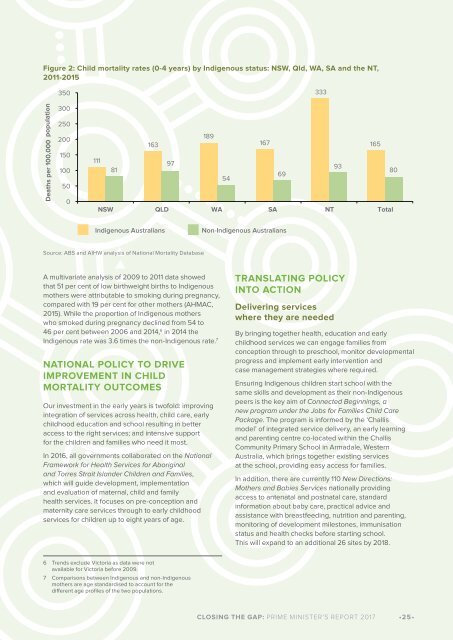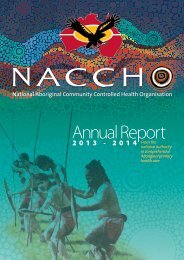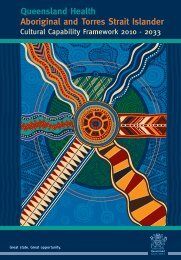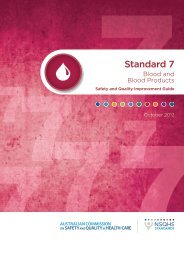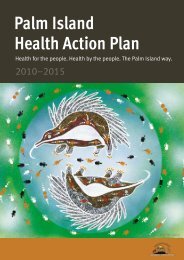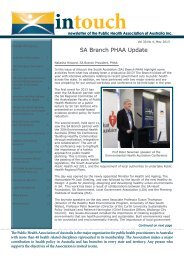CLOSING THE GAP
ctg-report-2017
ctg-report-2017
Create successful ePaper yourself
Turn your PDF publications into a flip-book with our unique Google optimized e-Paper software.
Figure 2: Child mortality rates (0-4 years) by Indigenous status: NSW, Qld, WA, SA and the NT,<br />
2011-2015<br />
Deaths per 100,000 population<br />
350<br />
300<br />
250<br />
200<br />
150<br />
100<br />
50<br />
0<br />
333<br />
189<br />
163<br />
167<br />
165<br />
111<br />
97<br />
93<br />
81<br />
80<br />
69<br />
54<br />
NSW QLD WA SA NT Total<br />
Indigenous Australians<br />
Non-Indigenous Australians<br />
Source: ABS and AIHW analysis of National Mortality Database<br />
A multivariate analysis of 2009 to 2011 data showed<br />
that 51 per cent of low birthweight births to Indigenous<br />
mothers were attributable to smoking during pregnancy,<br />
compared with 19 per cent for other mothers (AHMAC,<br />
2015). While the proportion of Indigenous mothers<br />
who smoked during pregnancy declined from 54 to<br />
46 per cent between 2006 and 2014, 6 in 2014 the<br />
Indigenous rate was 3.6 times the non-Indigenous rate. 7<br />
NATIONAL POLICY TO DRIVE<br />
IMPROVEMENT IN CHILD<br />
MORTALITY OUTCOMES<br />
Our investment in the early years is twofold: improving<br />
integration of services across health, child care, early<br />
childhood education and school resulting in better<br />
access to the right services; and intensive support<br />
for the children and families who need it most.<br />
In 2016, all governments collaborated on the National<br />
Framework for Health Services for Aboriginal<br />
and Torres Strait Islander Children and Families,<br />
which will guide development, implementation<br />
and evaluation of maternal, child and family<br />
health services. It focuses on pre-conception and<br />
maternity care services through to early childhood<br />
services for children up to eight years of age.<br />
TRANSLATING POLICY<br />
INTO ACTION<br />
Delivering services<br />
where they are needed<br />
By bringing together health, education and early<br />
childhood services we can engage families from<br />
conception through to preschool, monitor developmental<br />
progress and implement early intervention and<br />
case management strategies where required.<br />
Ensuring Indigenous children start school with the<br />
same skills and development as their non-Indigenous<br />
peers is the key aim of Connected Beginnings, a<br />
new program under the Jobs for Families Child Care<br />
Package. The program is informed by the ‘Challis<br />
model’ of integrated service delivery, an early learning<br />
and parenting centre co-located within the Challis<br />
Community Primary School in Armadale, Western<br />
Australia, which brings together existing services<br />
at the school, providing easy access for families.<br />
In addition, there are currently 110 New Directions:<br />
Mothers and Babies Services nationally providing<br />
access to antenatal and postnatal care, standard<br />
information about baby care, practical advice and<br />
assistance with breastfeeding, nutrition and parenting,<br />
monitoring of development milestones, immunisation<br />
status and health checks before starting school.<br />
This will expand to an additional 26 sites by 2018.<br />
6 Trends exclude Victoria as data were not<br />
available for Victoria before 2009.<br />
7 Comparisons between Indigenous and non-Indigenous<br />
mothers are age standardised to account for the<br />
different age profiles of the two populations.<br />
<strong>CLOSING</strong> <strong>THE</strong> <strong>GAP</strong>: PRIME MINISTER'S REPORT 2017<br />
•25•


